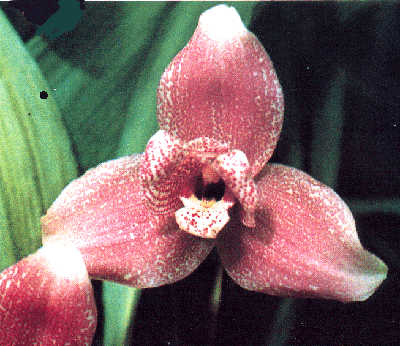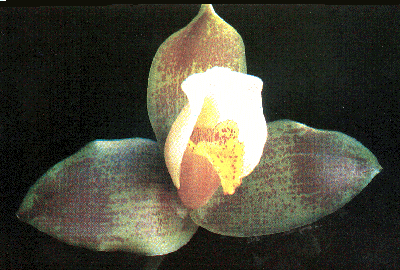INTRODUCTION
LYCASTES comprise an interesting and striking group of orchids. The following are general culture
notes. The monthly
cultural calendar will provide general cultural information, much of which will be relevant
to these orchids. These more specific cultural notes should be read in conjunction with those monthly recommendations.
General aspects of culture are discussed below under relevant headings. Certain elements of the
applicable culture follow where the particular requirements of the relevant Sections of the genus will be discussed.
I MEDIA
The mixes applicable to cymbidiums are generally adequate although the sieving out of the fine material from bark
mixes is often beneficial, in order to ensure fullest drainage. Those species which have the most marked growth
cycles, the spiny pseudobulbed Deciduosae species, will
respond to a coarser mix which can dry out during the usual winter rest period. About 7 to 15 mm sized pieces of
bark for these are appropriate. Other section species generally require a more even supply of moisture to be available
to the roots, and the inclusion of finer material, down to say 5 mm sized pieces, with perhaps the addition of
small quantities of sphagnum moss is more appropriate. However, watch the sphagnum moss, as this material can break
down quickly, making conditions unsatisfactory, especially if heavy fertiliser usage is followed.
All bark should be soaked before use, in water containing some fertiliser (especially nitrogen), and then allowed to drain before use. Straight
pine bark can be used, to which can be added pumice, scoria, polystyrene chips etc. The provision of good drainage
is very important, and this can be improved by placing large pieces of bark, pumice, broken pieces of clay pots,
etc. in the container for say one third of the container depth, with the usual media above. Most bark based mixes
have an effective life of some 2 to 3 years maximum. By this time organic decomposition will have broken the particles
down, making conditions unsatisfactory for continued growth.

Lycaste Auburn
2 POTS AND POTTING
For the Deciduosae, those species which dry during the
winter, and who have roots which in nature are exposed on bark surfaces, require an open mix in generally small
containers, i.e. tend to under pot. Other species such as macrophylla, skinneri and the Section Fimbriatae which naturally are
subjected to more equitable conditions require a finer mix, in containers which allow 2 to 3 years growth, as they
generally do not appreciate repotting too frequently. These plants, when growing well, will root vigorously, and
thus need room for this to occur. While constant moisture is required, the mix must never be stale, with free drainage
provided at all times.
Clay or plastic containers can be chosen. I have had success with both, although I feel the best growth has been
with clay containers, with the bottom drainage hole enlarged with crocking to the bottom third. Rigid plastic containers,
with extra drainage holes are satisfactory.
The actual process of repotting follows usual practice. Pot in the spring, ideally just as the new root growth commences so that re-establishment
is as fast as possible, usually when the new growths are 100 to 150 mm long. Carefully remove the plant, and clean
away the old mix and any dead roots. You can divide a plant now by breaking the rhizome, although often it is better
to cut the rhizome where desired earlier before the growth is broken in the spring, so the growth on the back cut
division can be got away before it is removed and separately potted.
Try and repot firmly but not too tightly; some staking may be required to hold the division if there are not many
roots left. Place the base of the pseudobulb some 10 to 15 mm below the top of the pot, with the mix just over
the rhizome. After repotting keep the plant warm and shaded and just damp until new root growth is apparent. Do
not forget to relabel all divisions. Old back bulbs not growing can be removed, and placed in a small pot, or in
a closed plastic bag with some sphagnum moss. Many will break into growth after some weeks, when they can be placed
on a small pot once new roots start to form. All flowering divisions should contain at least three pseudobulbs.
3 TEMPERATURE / HUMIDITY
There are a number of species which come from low altitude habitats, e.g. campbellii, powellii, ciliata var. rossyi. These require the highest temperatures,
conditions similar to that provided phalaenopsis being appropriate i.e. over 18 - 20 C. The spiny pseudobulbed
Deciduosae require intermediate temperatures, coming
from a slightly higher altitude in the foothill
monsoon mountain habitat, i.e. similar to that afforded cattleyas, although the seasonal
growth characteristics of these species should be noted. The moisture and heat is required during the period of
maximum vegetative growth (spring and summer). During the winter when the plant goes into dormancy, cooler conditions
will do no harm. The Macrophyllae and Fimbriatae Section plants which in the main come from the highest altitude
habitats require cooler conditions (cool/intermediate
10 - 15 C), although the species macrophylla from lower altitudes
appreciate some additional warmth. Minimum temperatures of 10 - 12 C overall are appropriate, with increased temperatures
as indicated. For both Lycaste and anguloas, maximum temperatures should not exceed 27 C at any stage. Some occasional
temperatures outside these extremes can take place without damaging the plants, although should be avoided if possible.
These plants appreciate a humid atmosphere, which usually cannot be provided adequately when the plants are grown
in a home. Free moving air is essential for their well-being; the use of fans running all the time is most beneficial.
Aim to keep the leaves moving gently m the air current.

Lycaste deppei 'Putnam'
4 SHADING
Shading is very necessary during the spring, summer and autumn as burning of the thin
plicate foliage can easily occur. The maintenance of a constant air flow and higher levels of humidity will prevent
burning in a lightly shaded glasshouse. I generally grow with light shade for most of the year, with medium shade
during the summer period only, but with good air movement and humidity control. Stronger light will generally ensure
the strongest growths, and maximum flowering.
5 WATERING
The Deciduosae must receive warm humid conditions when
in growth, but during their winter dormancy, just lightly water or mist to prevent undue shriveling of the pseudo-bulbs.
The Macrophyllae and Fimbriatae Section species should be kept moist all year, the actual frequency of watering
obviously changing with-varying seasonal conditions.
At all times do not overhead water The new growths comprise a 'tube' structure which can easily hold water. If
this occurs, and cool conditions arise, often rotting of the growth can occur.
Water freely when this is completed, allowing plenty to pass through the mix to wash away any salts which may have
accumulated. Fowlie notes that generally Lycastes are high altitude plants which are very sensitive to salts contained
in the water. If you are in doubt about the water supply, use rain water, although generally most piped supplies
will be found to be satisfactory in this country.
6 FERTILISERS
Some of the species grow in thick humus mats, and heavy fertilising of these plants will generally be appropriate.
The Deciduosae Section species and hybrids also require
some fertiliser, although the lower levels of application can be given. Always relate fertiliser usage to the growth
rate of the plants involved The use of a balanced general fertiliser is satisfactory, although a higher nitrogen
ratio is important in the spring. A little fertiliser often is a good generalisation for new growers. If heavy
fertiliser usage is considered, always ensure the growing mix is kept moist. In such situations if it is allowed
to dry out, often damaging concentrations can accumulate in the remaining water in the mix, which can kill the
roots. The use of capillary watering techniques can be useful in such situations to overcome this problem.
7 PESTS AND DISEASES
Generally lycastes are pest and disease free, although insecticides and fungicides may be necessary at times. Use
in accordance with normal orchid growing practice. It is, however, appropriate to note that some products can damage
the thin plicate leaves, some of the systemic products in particular being damaging at times. Always check a new
product on a few spare plants to test their reaction before applying to a whole collection.
8 GENERAL
Successful flowering is dependent on growing a large plump pseudobulb. Lycastes are clear in showing their appreciation
of good culture. Where conditions are not fully appropriate, pseudobulb growth will be restricted, but where everything
is fully to their liking, large plump pseudobulbs. will be quickly produced.
Spotting of the thin plicate leaves often indicates overhead watering has been wrongly used, often associated with
a lack of air movement. Severe spotting can also indicate root damage. If these signs appear, quickly consider
the main elements of your culture, and take the necessary corrective action your study indicates is appropriate.
Most species loose their leaves over the winter, so any unsightly foliage can often be removed once the pseudobulbs
are made up.
With the hybrids, the applicable culture will usually be the average for the species involved, weighted in terms
of the proportion of each species in the hybrid. If this is unsuccessful, especially in a hybrid containing species
from diverse habitats, experimentation will be necessary, with the conditions for each species tried until success
is obtained. Once established, most are readily adaptable to glasshouse culture. With all culture, try and ensure
maximum root growth. If a strong healthy root system is maintained, generally the rest of the plant will prosper.
9 FLASK PLANTS
Many people have problems with the establishment of flask plants, and it is hoped the flowing notes may be of assistance.
Deflasking will generally be most successful when completed in the spring. Generally, deflasking should not be
completed until the plants have formed small pseudobulbs in the flask although if the leaves have reached the top
of the flask then deflasking should be completed. Narrow necked flasks are broken after being wrapped in newspaper,
by tapping with a hammer or crushing in a vice. Wide necked flasks allow plant removal without breaking of the
container. The traditional method is to remove the agar, and, perhaps wash in water containing a weak fungicide.
While the plants will be sterile on removal, this may prevent any fungi becoming established in any wounds which
may have occurred during the deflasking process.
Separate the plants, and dry on the paper. If community pot planting is to be followed, grade the plants to similar
sizes for each pot. The individual plants can be potted into suitably moistened seedling grade bark, in individual
pots or together in community pots. A successful alternative technique is to place in loosely packed sphagnum moss;
this ensures moisture is available, but also provides plenty of air to the roots, which is most important. This
can be a most successful method.
Keep freshly potted plants warm and shaded. A plastic bottle or bag 'tent' can initially be useful to maintain
additional humidity. As plants establish more air can be given, and some weak fertiliser applied once growth is
strong. Kllen (D.M. Killen, 'Growing Lycaste Seedlings from Flasks', A.O.S. Bulletin) has suggested that deflasked
seedlings, because of their long thin roots which are invariably intertwined, should be planted initially as a
clump, as removed from the flask. She recommends filling a 100 mm pot half full with large sized bark, with small
grade bark then to 25 mm of the top of the container. The unseparated clump of plants is placed in the pot, with
the pot then filled with fine bark. The clump should not be buried too deep, the roots just covered, not the pseudobulbs.
Grow in humid areas with good air circulation with fairly low light levels. Leave in the clump until the new growths
developed on the first pseudobulbs are 25 to 50 mm high, then separate and repot the plants with bulb and growth
into small pots. The very smallest plants are placed in a standard community pot if appropriate. This recommendation
seems worthy of serious consideration.
Small plants can be also grown in a mix of 50~o rough peat, with the fine material re-moved, with pumice and sharp
sand added. This mix can contain a slow release fertiliser such as Osmocote. Pots with this mix can be placed on
a capillary watering mat to keep moist, and the higher fertiliser levels often used do not cause damage because
the pots can be kept near their optimum maximum moisture holding capacity. Every few weeks, flush the pots with
plenty of fresh water to remove any possible salt build up.
THE LYCASTE SECTIONS WITH SPECIFIC CULTURAL INDICATORS
This discussion is based on material of the late J. Fowlie as he published in the great magazine The Orchid Digest,
and his book The Genus Lycaste.
THE SECTION DECIDUOSAE
This group of Lycaste species is, with one exception, wholly from the North American continent. All the species
of this Section, with the exception of tricolor are prominently
armed with spines on top of the pseudobulbs arising from where the leaves break off, and which live in the drier
sections of the regions where they are known to occur. They usually grow as epiphytes on trees or on rocks, in
close proximity to semi- permanent streams or rivers. A total of ten species are included by Fowlie in this group
crinita, cruenta, campbellli, brevispatha are from the Pacific
slope drainage system aromatica, deppei, and consobrina primarily from the Atlantic drainage area, but do range to the Pacific
slopes. Macrobulbon is only found in the Caribbean catchment.
Tricolor is strongest in the Atlantic Costa Rica region although
a small dwarf race has been found on the Pacific slopes. Lasioglossa
represents a relict form in Fowlie's view, linking this Section to the Macrophyllae. The species are considered to have evolved on the dry Pacific slopes, generally only occupying similar
dry habitats of the Atlantic slopes in comparatively recent times.
It is relevant to look at the typical growth cycle of this grouping of species. Characteristically, their growth
pattern is one of vigorous vegetative growth during the rainy season of the tropics - usually May through to November
(November to May our Southern Hemisphere equivalents). This season is followed by a resting period varying from
2 - 5 months, during which the leaves are usually lost. The flowers appear simultaneously with the flush of new
growth in the spring, usually in our August to December. Fowlie notes that some specimens removed from their natural
habitats may get out of phase under cultivation and flower at almost any month of the year, apparently in response
to cyclical dryness and wetness, this apparently being of more importance in controlling flower production than
light intensity. This characteristic is worth remembering.
The Section Deciduosae can be divided into two sub-sections;
the Xanthanthae and the Paradeciduosae.
1 The Subsection Xanthanthae. This involves the deciduous yellow
Lycastes.
Aromatica, crinita, cochliata, consobrina, cruenta, bradeorum, campbellii and macrobulbon constitute a fairly uniformly close group, with deppei being somewhat
distinct. Lycaste lasioglossa links this Subsection to the Section Macrophyllae.
2. The Subsection Paradeciduosae
This is the second division of the Section Deciduosae of the genus Lycaste which contains the deciduous pink Lycastes.
Paralleling the yellow deciduous species, these how-ever have developed in the highland regions of Costa Rica and
northern Panama. The two species included here have pink flowers, brevispatha on the Pacific slopes, showing spines
on the pseudobulbs and subject to extreme rest conditions; and tricolor from the wetter Atlantic forests and which
cannot withstand very severe drought for very long periods. This plant also lacks spines on the pseudobulbs the
only plant of the Section Deciduosae to do so.
THE SECTION MACROPHYLLAE
This is regarded by Fowlie to be a highly successful group distributed from Guatemala in the north, and south to
Bolivia. It is a distinct group, with the species of Lycaste macrophylla forming a very large complex which is
currently at the height of its dispersal and differentiation. This Section is considered by Fowlie to be the youngest
member of the groups of species, occurring at elevations lower than the others, in regions where temperatures and
humidity, for example, are more uniform, leading to less specialisation from habitat pressure.
Because of the "macrophylla" complex, it is perhaps appropriate at this point to define 'what is a species;
what is a sub-species; what is a form'.
A SPECIES comprises an interbreeding population of individuals whose reproduction amongst themselves is controlled
by isolating mechanisms from other plants. The purity of a 'species' population is ensured by the following main
isolating mechanisms:
1. The species may grow in different areas, preventing crossing.
2. Most of the isolating mechanisms are reproductive
-they may grow in different habitats in the same area
- they may flower at different times
- they may be pollinated by different insects
-they may have a different floral and physiological structure which prevents cross-pollination between different
species.
Orchids are unique in that the flowers have developed distinct characteristics to reduce natural crossing between
species to an absolute minimum; as a result we find the orchid family shows the greatest floral diversity amongst
all families of flowering plants. Most other flowering plants utilise hybrid inviability (physical or chromosome
incompatibility) to prevent inter-crossing. Because orchids have largely developed other mechanisms limiting natural
pollen transfer to prevent different species hybridising, if man comes along and bypasses these constraints, both
inter species, and inter generic artificial hybridisation is possible, something which generally is not possible
to the same extent in other plant families.
The species can be seen to exist IF THE POPULATION INTERBREEDS but is also ISOLATED FROM THE OTHER SPECIES that
exist.
A SUB-SPECIES will consist of any interbreeding race of individuals which have one or more genetic variants. Whereas
between species there should be a lack of intergrades (plants showing some characteristics of the two 'species')
a sub-species will show a full range of intergrades. It will not have developed the necessary distinctive characteristics
or isolating mechanisms required to preserve the individual characteristics to continue as a 'species' of its own,
although it may eventually reach this status.
A VARIETY represents a colour phase of pigmentation variant which warrants separate designation.
A FORM is a plant showing structural variations; it may even be a monstrosity, that is distinct from the usual
species.
The above discussion is relevant, as Fowlie notes that the complex known as 'macrophylla consists of 7, and possibly
9, presently known sub-specific forms with two centres of radiation-one the Costa Rica-Panama Pacffic slopes and
the other the Peruvian Atlantic watershed. Additionally distinct species of the Macrophylla Section now recognised are Lycaste skinneri, dowiana, xytriophora, powellii,
leucantha and neglecta.
THE SECTION FIMBRIATAE
This is the final Section of Fowlie's consisting of nine species. These are distributed from Jamaica and Cuba to
southern Brazil, but are principally concentrated in the Andes of Colombia, Ecuador and Peru. These are considered
to be the oldest species of the genus which had ancestors predating the formation of the Andean mountains. The
two geographically extreme members are found at sea level to 600 metres (2000 feet) elevation. The other species
rarely found below 1500 metres (5000 feet) above sea level, these later forms believed by Fowlie to have evolved
in such a way that they could withstand the progressively higher and cooler climates resulting from the uplifting
mountain construct-ion.
The species of this Section show a fine fimbriation on the end of the lip, and are closely related to the genus
Xylobium. The relevant species included are barringtonia, ciliata, denningiana, fulvescens,
linguella, locusta, longipetala, longiscapa, and mesochlaena
I trust you will find the information on this series, and
on the remainder of my site, of interest and assistance.
If you have comments on the site content
or wish to discuss other matters I can be reached by
E-mail at [email protected].
|

 ;
;
